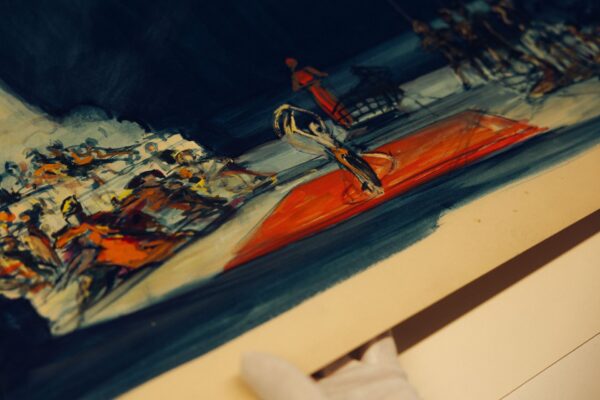The Graphic Collection of the German Theatre Museum
The graphic art collection of the Deutsches Theatermuseum comprises around 350,000 objects. The collection includes hand drawings and prints, i.e. original graphics as well as old and more recent reproduction techniques such as etching, copperplate engraving, steel engraving, wood engraving, lithography, offset, etc. In terms of content, the pictorial material in the collection is categorised into stage sets, set designs, costume pictures (i.e. figurines), role and civilian portraits and pictorial material on theatre architecture and theatre technology.

Collection history
It was created on the basis of the collection of Clara Ziegler, the founder of the Deutsches Theatermuseum, who had already attempted to record her own stage career using the medium of graphic art. After the Theatermuseum was founded, the scope of the graphic arts collection initially expanded due to its location: it focused in particular on the history of theatre in Munich and southern Germany, and then also on the entire German-speaking world, from the beginnings of German-language theatre history to the present day.
Early modern times and Baroque
The collection of graphic artefacts dates back to the early modern period via isolated and exceptionally rare objects dating back to the 16th century. The basis for the existing impressive focus on theatre graphics from the Baroque period, on the other hand, was created through acquisitions in the 1920s and 1930s and even in the 1950s. The music theatre of the 17th and 18th centuries proves to be an interconnected network of princely courts. The German Theatre Museum thus reaches beyond German-speaking fields of activity and takes account of the phenomenon of European Baroque theatre through significant objects.
19th century
The rapid development of printing techniques in the 19th century led not only to higher print runs but also to a considerably greater dissemination of visual material - including that of the theatre. Extensive graphic collections, many of them lithographic series on theatre events of the 19th century, not only depict settings, performance practice and theatre conventions, but also this context directly.
Special focuses
One of the largest collections of theatre portraits in the world is another important focus of the collection. In addition, individual estates of theatre professionals, such as the estate of members of the Quaglio family who worked as stage designers, or the estates of important theatre architects such as Gottfried Semper, represent relevant groups of holdings of great scope.
Theatre graphics in the 20th/21st century
With the invention of photography, it emerged as the strongest competitor to graphic art as a visual documentary medium for the theatre. As a result, since the beginning of the 20th century, theatre graphics have continuously lost their depictive function for theatre portraits and scenography. For more than two centuries, the design graphic fulfilled a primary and central function as a medium of expression for the graphic development of stage design.
In the meantime, digital drawing has replaced the analogue manual drawing skills of the set designer as well as the manually produced plan drawing of the theatre architect.
The graphic collection of the Theatermuseum continues to collect graphic testimonies that draw or inscribe, document and comment on the theatre of the past and present as images, and is growing through life's work drawings as bequests or legacies of stage or costume designers, such as the most recent 2023 by stage designer Karl-Ernst Herrmann.